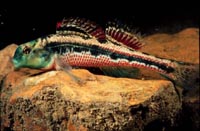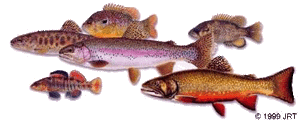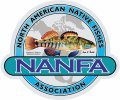| About NANFA |
| Home |
| Mission |
| Publication |
| Grant Programs |
| Administrivia |
| Join NANFA |
| Activities & Programs |
| Annual Convention |
| Regional Outreach |
| Breeder Awards Program |
| E-mail List Archive |
| FishMap.org |
| On-line Discussion Forum |
| Member Photo Gallery |
| For Sale |
| American Currents PDFs |
| Wisconsin's Fishes AC |
| HIDDEN RIVERS Snorkel Guide |
| NANFA Logo T-Shirts |
| Convention T-Shirts |
| Biology & Captive Care |
| Species Checklist |
| Conservation |
| Collecting |
| Fishwatching |
| Captive Care |
| Learning More |
| Fish in Focus |
| Web Links |
| Books & Journals |
Featured Native Fish Information Resources
 Splendid darter, Etheostoma barrenense
Splendid darter, Etheostoma barrenense© William Roston |
|
|
|
Native Fish Links
There are so many web sites with useful information that it is impossible to list them all. Here are a few recommended starting points. Most have links to other sites.
|
But first, a big NANFA "Thanks!" goes to Joseph Tomelleri. Through his exquisite artwork, Mr. Tomelleri has drawn the world's attention to the beauty of the native fishes of North America. We are proud to have him as a NANFA member and friend, and we ask that you visit his americanfishes.com website, where you can view and purchase his artwork. This is not a paid advertisement, and NANFA does not receive any money from these sales. We just want to say "Thanks!" |

|
|
Barewalls.com provides over 17,000 image results for "Freshwater Fish" out of the hundreds of thousands of fish pictures in their database. Barewalls' vast collection contains artwork that can be poster/print size and offer photography as well. |
BareWalls Posters and Prints

|
Information on North American Fishes and Aquatic Ecology
- Conservation Fisheries, Inc. (CFI)
CFI is a tax exempt, non-profit organization dedicated to the preservation of aquatic biodiversity. They propagate rare fishes with the goal of restoring populations that have been eliminated because of pollution or habitat destruction, and they also produce fishes for use in refining water quality standards. - Native Fish Conservancy
Native Fish Conservancy was formed to operate as a non partisan, nonprofit tax-exempt organization for the advancement of educational and scientific programs and initiatives. - The National Fish and Wildlife Foundation
The National Fish and Wildlife Foundation conserves healthy populations of fish, wildlife and plants, on land and in the sea, through creative and respectful partnerships, sustainable solutions, and better education. The Foundation meets these goals by awarding challenge grants to projects benefitting conservation education, habitat protection and restoration, and natural resource management. - The Great Lakes Information Network
The Great Lakes Information Network, or GLIN, is a partnership that provides one place online for people to find information relating to the binational Great Lakes region. Thanks to its strong network of state, provincial, federal and regional partner agencies and organizations, GLIN has become a necessary component of informed decisionmaking, and a trusted and reliable source of information for those who live, work or have an interest in the Great Lakes region. - The Upper Colorado River Endangered Fish Recovery Program
The Upper Colorado River Endangered Fish Recovery Programis a partnership of public and private organizations aimed at recovering endangered fish while also allowing for future water development. The upper Colorado River basin, which is composed of the Colorado River and its tributaries upstream of Lake Powell, is home to 14 native fish species, four of which are now endangered - the Colorado squawfish, razorback sucker, bonytail and humpback chub. - American Rivers
Celebrating over 26 years of bringing rivers to life, American Rivers is North America's leading national river-conservation organization. Their mission is to protect and restore America's river systems and to foster a river stewardship ethic. - Earthwave Society
Earthwave Society's primary mission is to provide information and education via television and educational videos to people around the world regarding biodiversity, sound conservation practices, and prudent utilization of our natural resources in order to insure healthy fish and wildlife populations in a healthy, thriving environment. - Fishes of Wisconsin
The entire text of George C. Becker's classic Fishes of Wisconsin is online! - National Wetlands Research Center
National Wetlands Research Center, whose mission is to develop and disseminate scientific information needed for understanding the ecology and values of our nation's wetlands and for managing and restoring wetland habitats and associated plant and animal communities. - The Natural History Museum
Online access to The Natural History Museum, London. - Our Living Resources: A Report to the Nation on the Distribution, Abundance, and Health of U.S. Plants, Animals, and Ecosystems
- American Fisheries Society
The American Fisheries Society is the world’s oldest and largest organization dedicated to strengthening the fisheries profession, advancing fisheries science, and conserving fisheries resources. - Southeastern Fishes Council
The Southeastern Fishes Council (SFC) is a nonprofit scientific organization dedicated to the study and conservation of freshwater and coastal fishes of the southeastern United States.
Other Valuable Sites and Organizations
- U.S. Fish and Wildlife Service
- American Killifish Association
- American Livebearer Association
- The Nature Conservancy
Aquarium Resources
- FINS (Fish Information Network)
FINS is an archive of information about aquariums. - Fish Link Central
Fish Link Central is a site you don't want to miss. You'll find links to hundreds of aquatics and fish pages. You can spend days here and travel the world, and find such unique and interesting topics as NANFA member Chris Scharpf's diary of his Amazon River collecting trip. - Biofilter.com: Aquatic Information Center
Lots of good info on shipping fishes, fish rooms, fish diseases, treatments, live foods, etc. - Colorado Aquarium Society
Aquatic Invertebrates
|
"The plight of freshwater mussels is a prime example Kevin Cummings and Christine Mayer, Illinois Natural History Survey,
|
 Photo © M.C. Barnhart; used with permission
Photo © M.C. Barnhart; used with permission
|
Introduced Species

- Nonindigenous Aquatic Species (NAS) Information Resources
NAS has information on introduced species, including original and present distributions, methods of introduction and status. You'll leave the NAS site with this important message: Don't ever release your aquarium fish! - Three sites on Exotic species in the Great Lakes:
- Center for Aquatic and Invasive Plants
- Nonindigenous Aquatic and Selected Terrestrial Species of Florida: Status, Pathway and Time of Introduction,
Present Distribution, and Significant Ecological and Economic Effects.
This is a wonderful summary of exotic species in Florida with many cited information sources. - Aquatic Nuisance Species Task Force
An intergovernmental organization dedicated to preventing and controlling aquatic nuisance species, and implementing the Nonindigenous Aquatic Nuisance Prevention and Control Act of 1990. - Four from the Illinois Natural History Survey:
- Nonindigenous species in the Gulf of Mexico
- American Fisheries Society Position on Introductions of Aquatic Species
Southwest United States Fishes

Devils Hole, NV. Photo by Tom Webster
- Desert Fishes Council
- Aravaipa Adventure
- Desert Springs Action Committee
A group of volunteers that takes a hand-on approach to desert fish conservation - The Salton Sea Home Page
Contains among its many topics the article "Status of the desert pupfish, Cyprinodon macularus " - The Dexter National Fish Hatchery and Technology Center
Located in southeast New Mexico, it is the only facility in the nation dedicated to holding, studying, culturing, and distributing endangered fish for restocking in waters where they occurred naturally. It is the central component for the protection, restoration, and recovery of the endangered and threatened fishes of the Southwest.
A Few Other Native Fish Pages
- Australia-New Guinea Fishes Association (ANGFA)
NANFA's sister organization Down Under. We applaud their efforts in behalf of their continent's fishes.Also visit Australian Desert Fishes Page, by NANFA member Peter Unmack
- The Aquatic Bookshop
A great selection of new and used books, magazines and videos for beginners to advanced aquarium, fish, reptile and amphibian hobbyists - The Love Lab Home Page, full of hilarious anecdotes and facts and photos of Pacific marine fishes
- Jonah's Aquarium, a place to buy native fishes and supplies
- Gambusia Control Homepage You've heard of mosquito control -- how about mosquitofish control?
- The Sturgeon Page and Sturgeon For Tomorrow
- Cold Spring Harbor Fish Hatchery and Aquarium, operated by NANFA member Norman Soule
- Tennessee Aquarium
- Biospeleology: The Biology of Caves, Karst, and Groundwater
- In Search of the 'Wild' Red Swordtail
- The Tadpole Madtom Noturus gyrinus
- Three Darters Found in Minnesota Rivers
- Understanding Large-River Fish Communities
- Species Spotlight: The Common Stoneroller
- Spring Pygmy Sunfish, One of Alabama's Rare Fishes
- The Rivulus marmoratus webpage
- Native Fish Research Group at the University of British Columbia
- Fine Art Wildlife Carvings, by NANFA member Jim Roberts in Winnipeg
- Video: To Build A Better Ditch.
